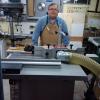This is probably a silly question but...... what are some good techniques as far as measuring before cutting?
I've done simple wood projects for a long time now with basic tools but have recently upgraded to a rail system (EZ smart) which has made my cutting abilities about 100 times more accurate than they were.
Which in turn has made me realize that although I can cut extremely accurately now , I now need to make sure my measurements (and markings on the wood) are perfect too.
Having been essentially self taught, I've always used basic things like tape measures, rulers, and simple squares..... but if anyone has any special tips or measuring techniques they can share, I would be grateful..... and perhaps something that is obvious to you might be new to me.
My next big project is kitchen cabinets and I've realized I need to be in the sub 1/16ths of accuracy which is maybe the width of a pencil line or blade width.
And while I can now cut that with the rail system no problem, I'm still not 100% confident I getting that kind of accuracy in my initial measurements of markings. Thanks!




 Reply With Quote
Reply With Quote






